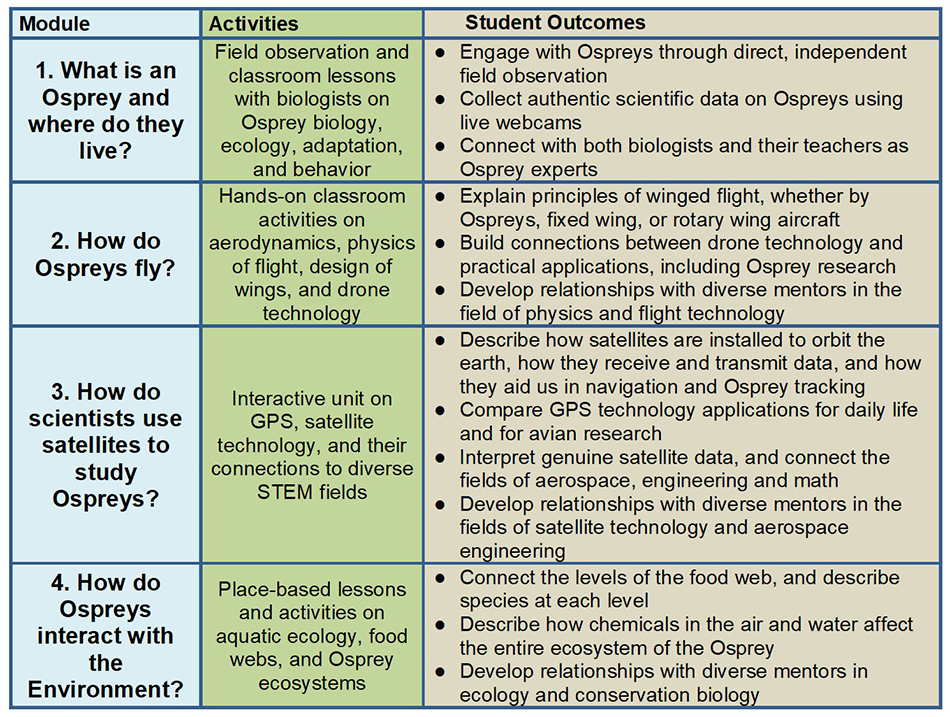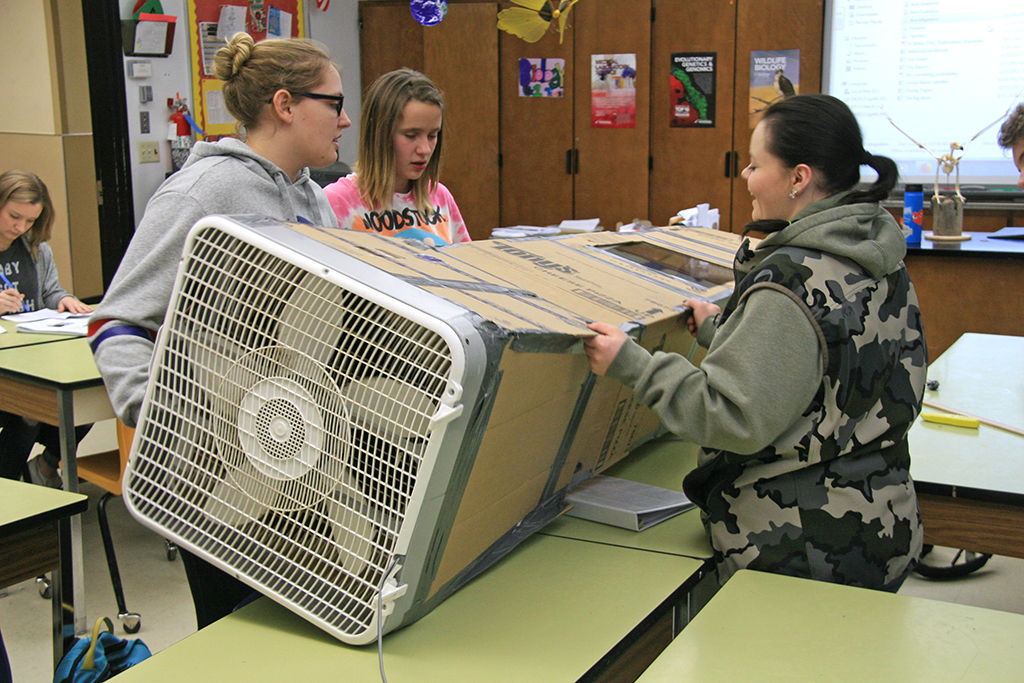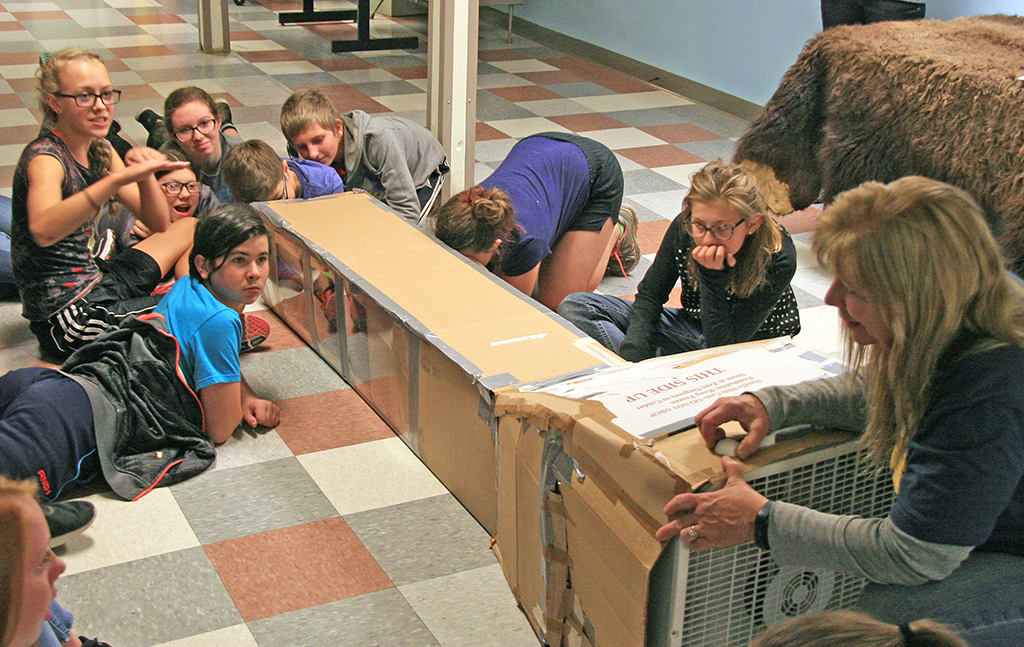Feature
Wings Over Water
Museums, Scientists, and Teachers Collaborate to Spark Student Interest in Science Through the Study of Ospreys
Connected Science Learning January–March 2020 (Volume 2, Issue 1)
By Allison De Jong, Jenélle Dowling, Erick Greene, and Sharon Leigh Miles
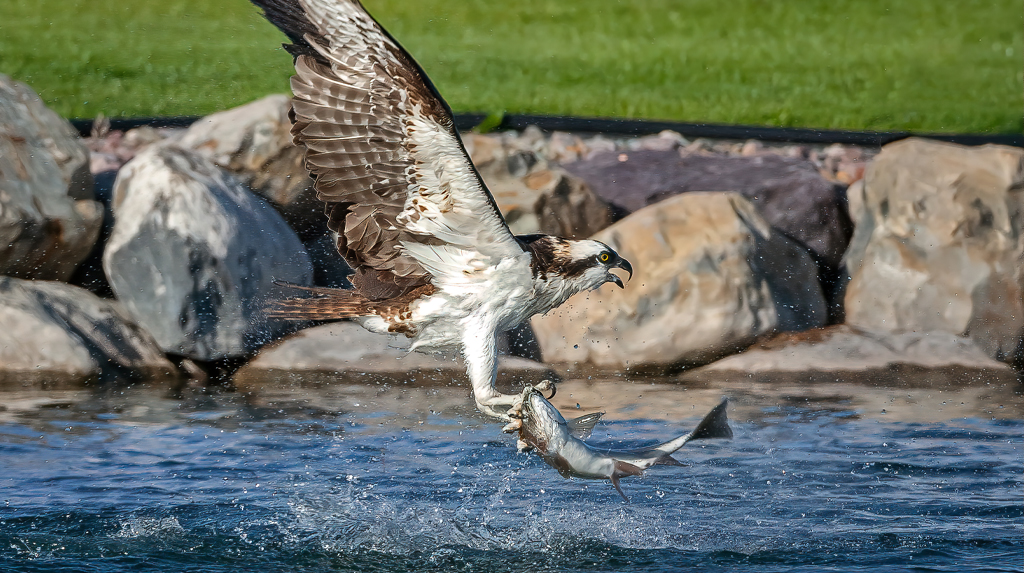
The Wings Over Water (WOW) collaboration began with ospreys.
Anyone who’s seen one of these highly specialized fishing raptors plummeting from high above the water to catch a fish knows how captivating this species is. The birds’ M-shaped silhouettes can be seen winging above waterways on every continent except Antarctica, and they migrate thousands of miles to return to the same nest for years, sometimes even decades. As the top predator in many aquatic ecosystems, they are important indicators of the health of our streams, lakes, and rivers. Perhaps for these reasons, or perhaps because they are simply beautiful and familiar birds, people love ospreys.
Ospreys tolerate human activity and thus are easy to observe: Erect a nest pole and students and teachers are likely to have a breeding pair to study. Ospreys are well suited to excite and motivate students and provide unique learning experiences in E-STEM (environment, science, technology, engineering, and math).
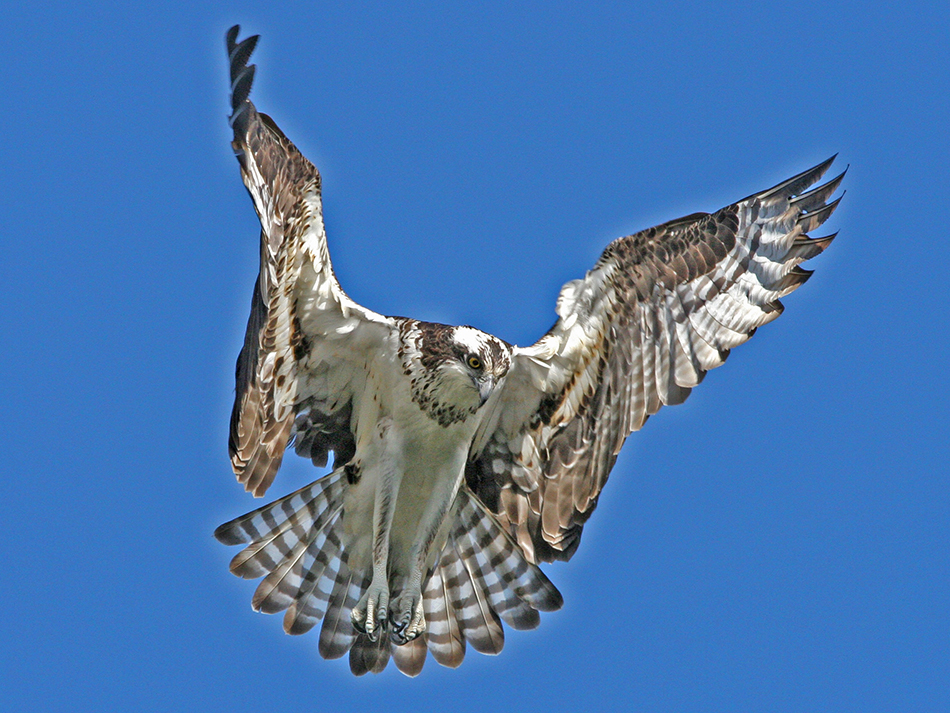
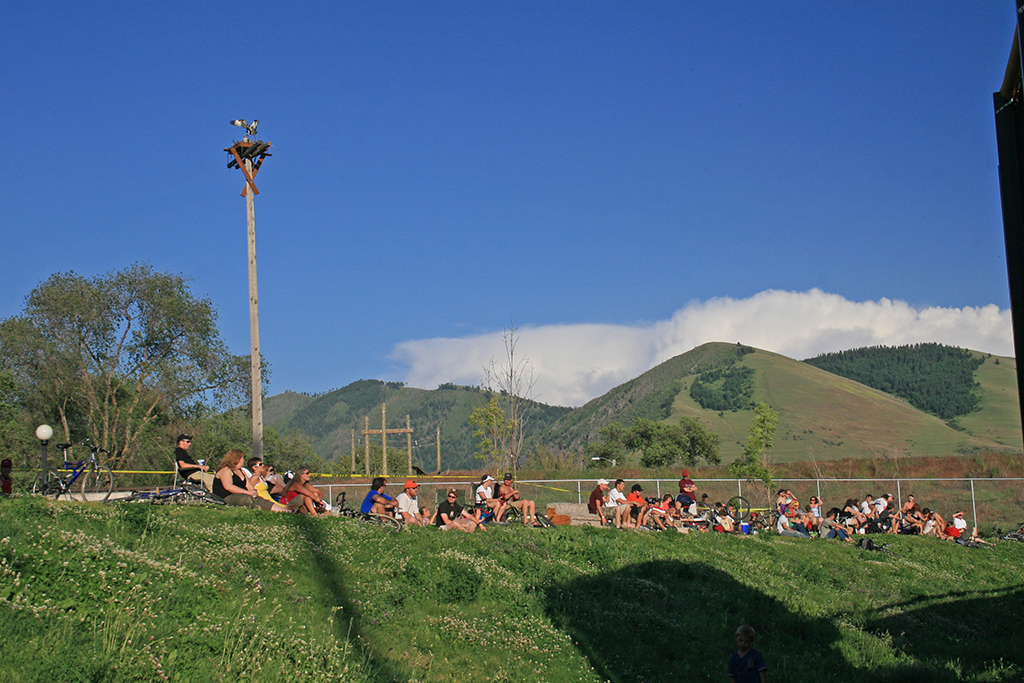
Inspired by ospreys
The Montana Osprey Project started over a decade ago as a collaboration between Rob Domenech (director of Raptor View Research Institute), Dave Taylor (of Dave Taylor Roofing—he provided the bucket trucks needed to get up to osprey nests), Dr. Heiko Langner (an environmental chemist, now the director of the Analytical Chemistry Core Lab at King Abdullah University of Science and Technology), and Dr. Erick Greene (an ecologist and behavioral biologist at the University of Montana [UM]). At the time, the Clark Fork River in western Montana was part of the largest Environmental Protection Agency (EPA) superfund site: Because of a long history of copper mining, the river had extremely high levels of certain heavy metals. The project’s original purpose was to analyze the blood and feathers of osprey chicks to measure their levels of these heavy metals, which was a way for researchers to monitor the effectiveness of the massive cleanup efforts of the Clark Fork River.
Whenever members of the Montana Osprey Project visited an osprey nest, they invited kids and members of the community to learn more about ospreys, aquatic ecology, and the importance of clean water. Then they installed an osprey nest camera in Missoula, Montana, and Iris—the female osprey nesting here—and her mates became international superstars, with thousands of people from all over the world tuning in during each breeding season.
The Montana Osprey Project team realized there was a huge potential for much deeper and richer educational programs. Dr. Greene had already been inspired by the Green Eggs and Sand program in Maryland, which uses horseshoe crabs to bring E-STEM education to schoolchildren along the East Coast of the United States. Dr. Greene realized that the osprey is another ideal species around which to build a rich, integrative E-STEM curriculum. And so the Wings Over Water program was born.
WOW connects middle and high school learners to environmental issues, nature, and their place, all while engaging them in E-STEM learning. WOW reaches these students through their teachers, building classroom educators’ E-STEM capacities through a weeklong, interactive, field-based professional development workshop in Missoula, Montana. During this summer institute, teachers become E-STEM teacher-scholars, learning from experts in the field about avian biology and aquatic ecology, as well as math, the physics of flight, and satellite technology. These teachers in turn take their new knowledge and enthusiasm—and their connections to science experts—back to their classrooms to spark their students’ interest in E-STEM topics.
The WOW collaboration
Since its inception, the WOW program has been a fruitful symbiosis among many groups. WOW is embedded within the Montana Natural History Center (MNHC), a nonprofit organization whose mission is connecting people to nature through education. When Dr. Greene went looking for partners for his project, MNHC was a natural fit; the organization already provided science and natural history education to thousands of elementary school students and hundreds of adults, and had experience running in-depth professional development workshops to train K–12 formal and informal educators in E-STEM subjects. The one gap that remained in MNHC’s offerings was a dedicated program to reach middle and high school students.
Once MNHC was on board and had hired avian researcher and educator Dr. Jenélle Dowling as the staff scientist to help develop and coordinate WOW, the next step was to collect a diverse group of experts. The Montana Osprey Project team (including Domenech and his biologists from Raptor View Research Institute, Greene, and Dalit Guscio, the restoration education program manager from the Clark Fork Watershed Education Program/UM) could offer groundbreaking ecology research on heavy metal contaminants in the Upper Clark Fork River, osprey migration, and the local aquatic ecosystem. With support from these researchers, several local middle and high school teachers, and expert educators at MNHC, Dr. Dowling crafted a dynamic curriculum including everything from ecology to aeronautics and satellite tracking, aerodynamics and flight, math, physics, engineering, and more. And, to make the curriculum as relevant as possible for educators, not only did several middle and high school teachers assist with the curriculum development, but the WOW team also created each module and lesson with the Next Generation Science Standards (NGSS) in mind, focusing all of the content through the lens of the standards. We also reached out to experts from the Montana Space Grant Consortium, Lockheed Martin aerospace company, the UM Flight Laboratory, the UM Environmental Biogeochemistry Laboratory, the Clark Fork Watershed Education Program, the National Wildlife Federation, and spectrUM Discovery Center to lead hands-on demonstrations and provide teachers firsthand experience with active research during the WOW summer institute.
All of these partners are essential members of the WOW experience. One of the most exciting aspects of WOW is that the program invites teachers and students into the heart of the research process. Instead of learning about physics, math, or ecology from a textbook, WOW teachers and their students engage directly with biology, chemistry, math, physics, engineering, and technology while participating in scientific research.
During the weeklong professional development institute, teachers are immersed in the four broad modules of the WOW curriculum—the same modules that they’ll work through with their students in the fall (see Figure 1).
- Osprey biology: What is an osprey and where do they live? Teachers are introduced to basic biology of ospreys, and these general concepts are springboards to additional themes of adaptation, anatomy, life cycles, behavior, ecology, and population biology.
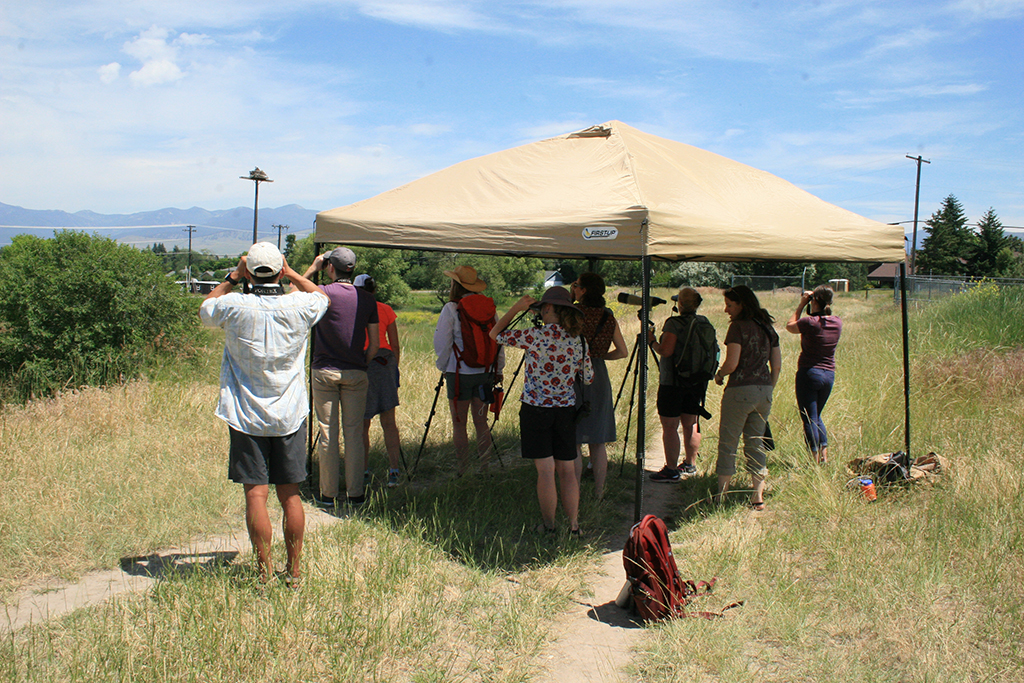
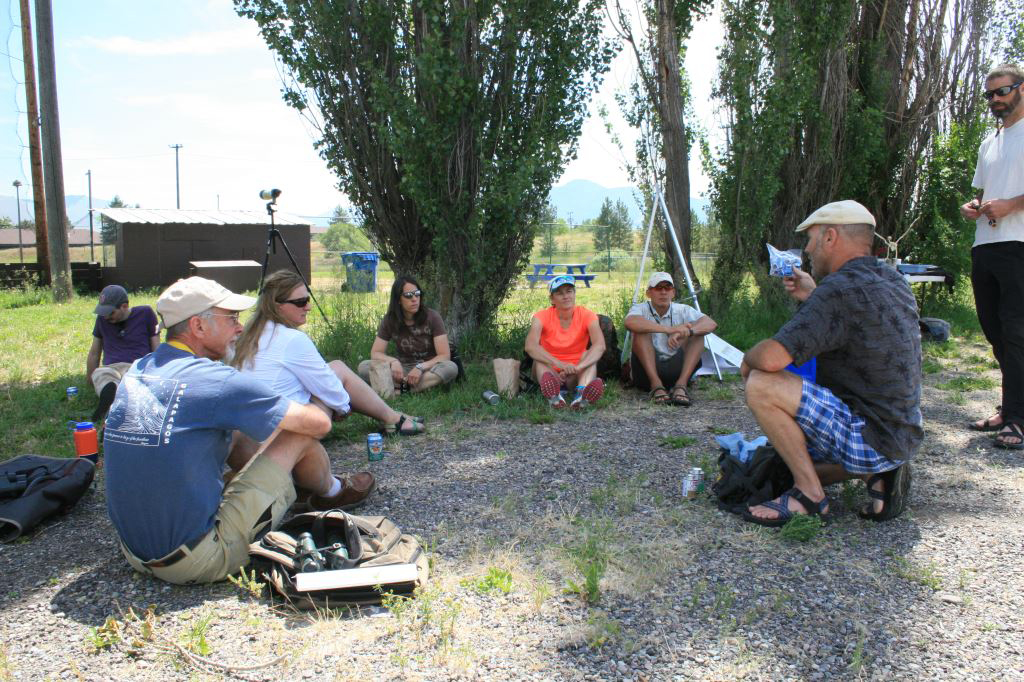
- Aerodynamics: How do ospreys fly? Teachers learn about the basic aerodynamics of flight. They study the physics of flight and the design of aircraft from pilots at Neptune Aviation/Northstar Jet; visit UM’s world-class Flight Lab to learn about aerodynamics, wind tunnels, bird flight, and research methods; build their own wind tunnels out of cardboard boxes and a fan; and are able to design and test their own paper airfoils.
- All about GPS: How do scientists use satellites to study ospreys? Just about every student has a smartphone. How does the phone know where the student is? This is a fun module that introduces the satellites circling overhead, rockets and trajectories, Newton’s laws, how GPS works, and how researchers can use small GPS backpacks on ospreys to study migration patterns. WOW teachers get first-hand information on these topics from Rodrigo Zeledon, a lead satellite scientist with Lockheed Martin aerospace company. This module allows teachers and students to explore a wide variety of topics in math, physics, and aerospace engineering.
- Ospreys and the environment: How do ospreys interact with the environment? Because they are at the top of aquatic food chains, ospreys have been considered environmental sentinels for a long time. WOW teachers learn how ospreys are used to study the environment, chemistry, the birds’ physiology, the creatures’ place in food webs, and conservation biology. Teachers participate as biologists from Raptor View Research Institute collect blood samples from osprey chicks. Teachers also connect with chemical ecologists in UM’s state-of-the-art environmental biogeochemistry lab as the scientists analyze the blood samples.
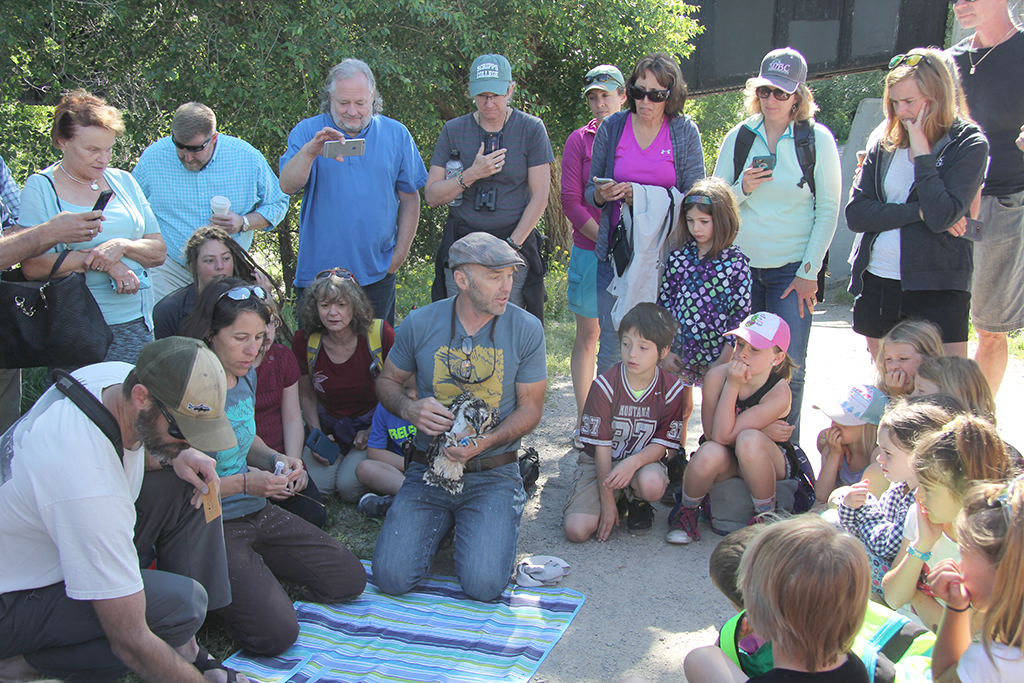
The WOW program makes science come alive. It helps turn teachers and their students into inquisitive researchers.
Living science
“Students perceive science in silos: This is life science. This is physical science. This is Earth science,” says 2018 WOW teacher Cliff Marr. “What WOW brings to the table is that students are able to see how different areas of science interact with each other. Students are able to take a technology that they take for granted, such as GPS, and see that physics, math, material[s] science, chemistry, and biology all play roles in a working GPS system. The WOW program presents science, technology, art, and engineering as a whole connected web, not as units or chunks of knowledge.”
Although every teacher implements the program a little differently—from picking just a few lessons to incorporating most of the curriculum depending on grade level, time constraints, and classroom needs—they all have the opportunity to work with a collaborative team of expert researchers. When the teachers return to their classrooms in the fall, WOW staff at MNHC and UM support teachers in their curriculum delivery throughout the school year—and throughout subsequent school years—through regular meetings, in-person and virtual E-STEM expert visits to classrooms, field trips, and demonstrations. WOW staff also connect teachers to local leaders in the fields of biology, physics, and aerospace technology. “The entire workshop was based on active and ongoing STEM research,” says a 2019 WOW teacher. “Now we have an opportunity to take part in this research by extending it to areas where we teach.”
Working with such a diverse, collaborative group provides students with endless opportunities to develop interest in a variety of E-STEM topics, and to develop relationships with enthusiastic role models who work in those fields. This innovative approach allows students to engage with science in a personally meaningful way—designing, planning, and carrying out their own investigations—which has been proven to foster lifelong interest in E-STEM, especially for groups under-represented in science, such as women, and ethnic and cultural minority groups (PBS 2014; Kelley and Knowles 2016).
“The integration of engineering and technology within the WOW curriculum has helped me transform my science and math classes into true STEM classes,” says 2018 WOW teacher Betsy Craske. “The lessons are relevant, innovative, and hands-on, which means that my students are getting a one-of-a-kind learning experience that will help them in STEM fields in their future studies and careers. This program has facilitated opportunities for me to expand student learning outside of the classroom walls in an exceptional, hands-on way.”
Program reach
Now in its third year, WOW has fledged beyond its initial Montana beginnings and is attracting teachers from all across the United States. WOW is currently implemented in 26 middle and high schools in Montana, Washington, Idaho, New Jersey, Minnesota, and California, reaching nearly 2,000 students in 14 rural schools, seven small-town schools, and five city or suburban schools. Although WOW staff cannot provide in-person support for teachers in other states, they do check in with these educators regularly throughout the year, offering advice and feedback as teachers work through the curriculum modules, helping them connect to local nest cameras, and even sending specimens and other resources by mail.
Several of the counties in Montana and other western states currently participating in WOW have populations greater than 65% American Indian, with four schools on tribal lands, and the majority of counties in the program have a population of between 2% and 25% American Indian. Montana’s Indian Education for All standards were explicitly incorporated into the WOW program.
Many students in the communities that WOW reaches have lacked engagement and foundational skills and knowledge in E-STEM, are unlikely to pursue E-STEM careers, and are at risk for delinquent behavior. Programs such as WOW—place-based, local, integrated—significantly improve E-STEM indicators for rural, low-income communities (PBS 2014; Kelley and Knowles 2016). WOW addresses critical needs for students and communities by specifically serving economically disadvantaged students in rural and tribal regions. Twenty-three of the 26 schools WOW currently reaches are eligible for Title I funding. WOW provides many rural students with their first exposure to environmental research and puts an E-STEM mentor—their teacher—in the classroom.
Empowering educators
WOW gives both teachers and students confidence in E-STEM subjects; several WOW teachers and students have been recognized at state and national levels for their involvement in E-STEM. Patti Bartlett-Gladstone from Seeley-Swan Elementary and Junior High School received the 2018 Montana Environmental Education Association Educator’s Award for being a “fearless science teacher and scholar, who combines timely and impactful science topics; culturally relevant learning; indigenous knowledge; and real, muddy field biology into her classes.” And 2017 WOW teacher Caitlin Webb, who taught fifth through eighth grade at Dixon School in Dixon, Montana, won an honorable mention for the EPA Presidential Innovation Award for Environmental Educators for her creative implementation of the WOW curriculum in her physics, math, and science classes. In addition, two seventh-grade WOW students from Colville Junior High School in Colville, Washington, presented their osprey research at the 2018 North American Association for Environmental Education (NAAEE) conference, where they won the STEM Award for their leadership and outstanding work in science education.
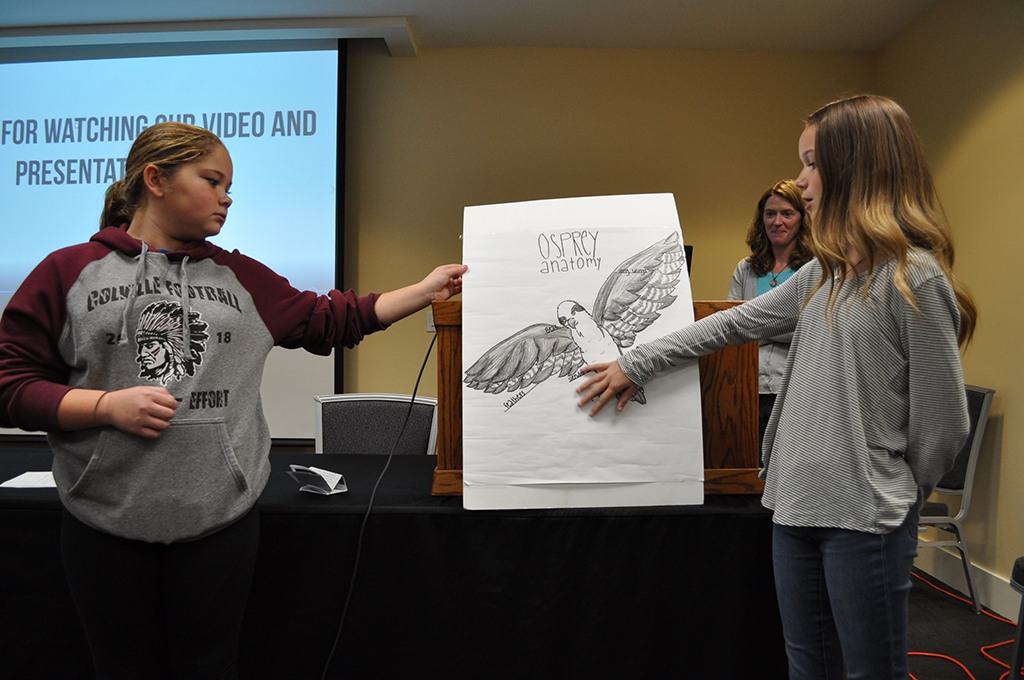
WOW focuses on helping teachers become E-STEM teacher-scholars with the confidence, resources, and professional support to engage their students in research. These teachers are supported by the guidance of the program curriculum and each lesson’s foundation in the NGSS. After participating in the WOW workshop, all educators indicated via the pre- and postworkshop evaluations that they
- see themselves as an E-STEM scholar more than they did before the workshop;
- feel more confident about their knowledge in E-STEM fields;
- have more access to professional researchers doing work in E-STEM fields;
- had exposure to active and ongoing E-STEM research;
- feel more confident that they can find and bring E-STEM experts into their classrooms;
- became part of a community that works together to exchange knowledge, ideas, and expertise;
- have a stronger ability to teach E-STEM topics in an integrated manner;
- have the opportunity to present E-STEM topics in a way that is personally meaningful and relevant to their students; and
- are able to provide students better access to engaging E-STEM materials and resources.
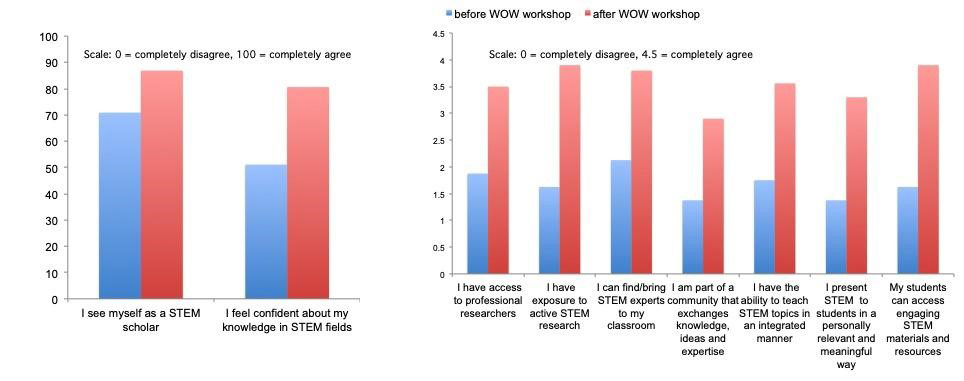
One 2019 WOW teacher wrote, “I feel much better about my ability to [teach E-STEM subjects] now. I still feel like I need to learn more myself, but I’m not as afraid now to learn as I go rather than waiting to be an expert in the topic before trying to teach it.”
Just a few days after she attended the 2019 WOW workshop, teacher Christine Karlberg wrote: “Yesterday I want paddleboarding in Newport Back Bay [in Newport Beach, California] to look for our local osprey nest. As I continued to paddle on, I noticed the vortices my friend’s paddle made in the bay. I noted the shape of the plane wings as they flew overhead. I wondered at the musculature that kept the legs of the egrets tucked up so aerodynamically (to reduce drag) for such a long time. Looking down in the water, I saw tons of stingrays ‘flying’ through their own medium! I learned SO MUCH in a week. I can’t wait to try the WOW curriculum with my students. I’d love to return to Montana next year to share lesson ideas with other teachers!”
Since WOW’s inception, our teachers have helped us build and expand the curriculum. The WOW team relies heavily on teacher feedback both during the professional development institute and throughout the school year to adjust the curriculum. We are constantly tweaking the program according to teachers’ experiences. Thanks to their expertise and insight, our curriculum now includes lessons on the significance of ospreys in American Indian history and culture, in-depth lessons that analyze Montana land-use impacts on ospreys and other birds, hands-on collaborative lessons exploring every aspect of flight physics, and lessons that use satellites to monitor effects of climate change from outer space.
Students take action: Classroom–community collaboration
Once teachers return to the classroom, they continue to work with the WOW team of experts, as well as forge new connections in their communities. With their fresh access to research, tools, and teaching methods commonly used at the college level, WOW teachers connect their lessons to local environmental challenges related to E-STEM, choosing the lessons and modules that work best for their individual classrooms and grade levels. They work with their students toward a capstone service-learning project that is informed by the research students have been conducting throughout the year as they work through the WOW curriculum modules. Students use their newly gained E-STEM knowledge to generate their own research questions, collaborating with professionals in their community to identify and help solve a local environmental problem.
2017 WOW educator Rich Montoya teaches at Hardin High School in the heart of Montana’s Crow Reservation. “I integrated the WOW curriculum with specific questions about our local land by connecting lessons to ‘Crow-centric’ concepts,” he says. “I had students read the Crow Treaty and understand it. Then we focused on the land—how mining, money, fish, and game fit in with Crow Nation. Water in Crow Nation/Hardin is so contaminated that ospreys fish in some areas, but not others: a real-life example. My students took water samples from locations near their homes, tested them for microorganisms, and plotted [data] in a Google database used by actual researchers. After locating osprey nests below, but not above a dam, students conducted field studies to answer [the question]: ‘Why is the water clean above the dam, but polluted downstream, on land leased from the tribe?’ In this lesson, we focused on ‘heritage’ as it’s associated with water quality and osprey health.” The class is now sharing results with the public and following up to find solutions with local tribal and governmental agencies.
Another WOW class, in Seeley Lake, Montana, noticed that their local osprey pair had built a nest on a dangerous high-voltage transmission pole, right on the main street in their town. The class worked together with the local electric co-op, several landowners, and WOW program biologists to relocate the nest. Students used the engineering design process to create plans for a platform and supports, and made scale model mock-ups to test different designs. They secured a donated platform and pole, had them installed, and moved the nest to the new, safe location, as the local community looked on.
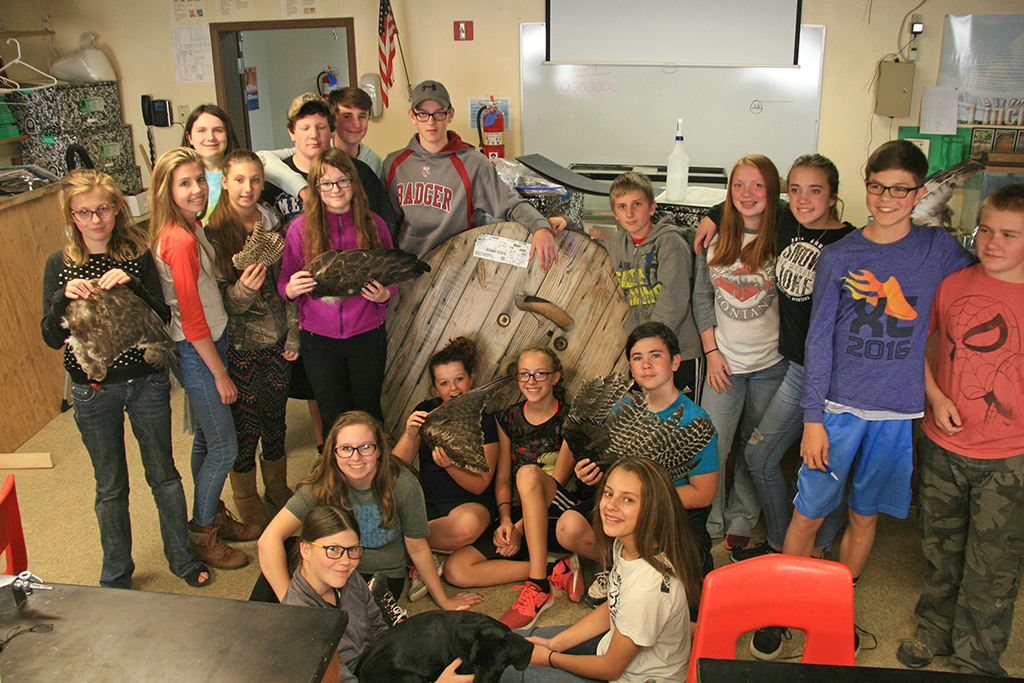
“It was definitely a once-in-a-lifetime experience,” says 2017 WOW educator Patti Bartlett-Gladstone, who taught the students who relocated the nest. “We looked at the latest engineering model for osprey nests, and the class came up with several ingenious innovations, and that’s what we built in real life. It was a hands-on project and it’s something that needed to be done, and it was something the community really wrapped themselves around. It helped kids, ospreys, and the community.” (Read more of the story here.)
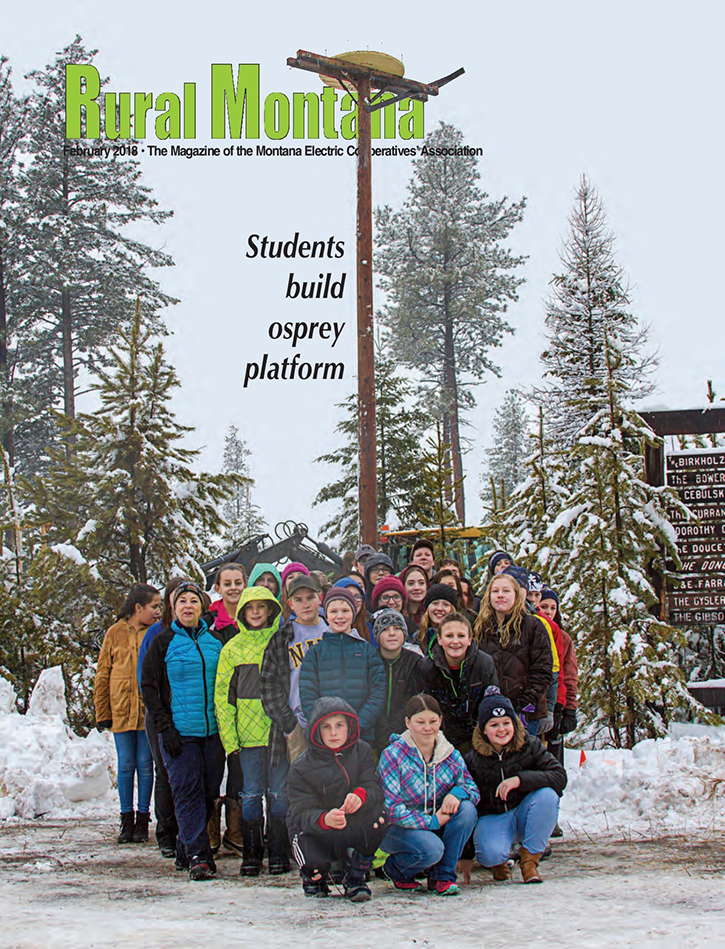
Replicating the program
In the same way that Wings Over Water used the Green Eggs and Sand program model as inspiration, other institutions can replicate similar programs in their own communities by using an exciting and locally relevant species or phenomenon as a bridge to E-STEM, thus integrating physics, biology, engineering, and ecology. Centering an E-STEM program around a local species lets educators bring real-world science to their students and creates the opportunity to work with a diverse team of community experts—scientists, agencies, nonprofits, museums, environmental educators, and more.
It is its diverse group of partners that allows WOW to provide its programming to educators for free. WOW does depend on some grants and private funding, but much of the support is in-kind. Having a university as a key partner has been essential to WOW’s success. WOW was born from research already being done by UM; communities looking to replicate this program can seek out universities, researchers, science centers, state agencies, and citizen science programs to identify a species upon which to center their program.
With so many collaborators, however, it’s important to ensure that involvement in the program is mutually beneficial to the program and all its partners. We made sure that WOW helps the pilots at NorthStar Jet/Neptune Aviation and researchers from UM, Lockheed Martin, Raptor View Research Institute, and Clark Fork Watershed Education Program achieve their personal or institutional goals for broader impacts and science outreach in the community. For environmental education organizations such as spectrUM and the National Wildlife Federation (NWF), we provide meaningful outreach or education—helping NWF recruit teachers from WOW for their Eco-Schools program and having the WOW teachers lead E-STEM lessons for spectrUM’s summer camp during the professional development institute. And, when the teachers bring the program back to their classrooms, the research their students conduct benefits their communities, partner researchers, and fellow program participants, too.
Perhaps the strongest aspect of the program is that the WOW curriculum is a living document, constantly being tweaked and adjusted according to teachers’ experiences. The teachers themselves get to inform future iterations of the curriculum, providing feedback throughout the year on what worked and what didn’t in their classrooms, helping the WOW team—as well as their fellow educators—build, expand, and improve the modules for years to come.
At its very core, WOW is a collaborative, symbiotic program that benefits all its partners.
Allison De Jong (adejong@montananaturalist.org) is communications coordinator at the Montana Natural History Center in Missoula, Montana. Jenélle Dowling (jenelle@adventurescientists.org) was staff scientist and Wings Over Water coordinator at the Montana Natural History Center in Missoula, Montana, and is now scientific director at Adventure Scientists in Bozeman, Montana. Erick Greene (egreene@mso.umt.edu) is professor in the Division of Biological Sciences and Wildlife Biology Program at the University of Montana and codirector of the Montana Osprey Project in Missoula, Montana. Sharon Leigh Miles (sharonleighsc@gmail.com) is a volunteer with the Montana Osprey Project in Missoula, Montana.
Want to learn more?
Want to apply to this year’s program? WOW is now accepting applications for the 2020 summer institute, taking place June 22–26 at the University of Montana in Missoula.
Resources
Missoulian article on osprey banding
Montanan article on ospreys and Montana Osprey Project (pp. 17–19)



